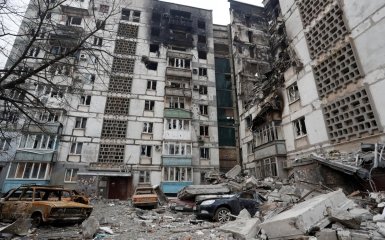Representatives of human rights organizations Human Rights Watch, SITU Research and Truth Hounds have published an investigation dedicated to the involvement of the top leadership of Russia in the commission of war crimes in occupied Mariupol.
How the Russian army destroyed Mariupol
Human rights activists devoted the investigation to the events of spring 2022 when the criminal army of the Russian Federation stormed Mariupol.
According to the investigators, the Kremlin dictator Vladimir Putin, the head of the Ministry of Defense of the aggressor country Sergei Shoigu and the so-called head of Chechnya, Ramzan Kadyrov, may be involved in war crimes in Mariupol.
The investigation materials state that before the large-scale invasion of the Russian army into Ukraine at the end of February 2022, 540,000 people lived in Mariupol.
In particular, the city was a significant cultural and industrial centre in southeast Ukraine.
People came from all over the country to see regional theatre performances or a concert at the Chamber Philharmonic.
There were two largest metallurgical plants in Mariupol. Local authorities have invested hundreds of millions of dollars in constructing roads and parks and creating a modern public transport system.
The Sea of Azov was both a business card and a guarantee of development simultaneously. Through the port of Mariupol, Ukraine supplied coal, steel and grain to various parts of the world.
After the invasion of the criminal army of the Russian Federation into Ukraine, the Russian occupiers almost immediately began an offensive in the direction of Mariupol. They stormed the city for several months, seeking to create a land corridor with the occupied Crimea.
Mariupol was surrounded at the beginning of March 2022, and some Russian army units attempted to advance to the city centre.
Mariupol was bombed from the air, shelled by tanks, mortars and heavy artillery.
Many residents left their homes and moved into basements, until the beginning of March there were approximately 450,000 people who either could not or did not want to evacuate.
As a result of hostilities, infrastructure was destroyed, and residents were left without water, heat, light, or communication.
By April 13, the occupiers had captured most of the city, and on the 21st, Moscow announced its capture.
In mid-May, the remnants of the Ukrainian garrison, which were defending themselves on "Azovstal", surrendered.
As a result of the Russian occupation, the city was almost destroyed.
Since human rights defenders did not have the opportunity to gather information at the events scene, the testimonies of hundreds of residents of Mariupol who managed to evacuate were used, 850 photos and videos were processed, and satellite images of cemeteries were analyzed.
Human rights defenders studied every quarter in the central part of the city to assess the damage.
In their work, they focused on the destruction along the city's central street — Mir Avenue. An area of approximately 14 square meters was studied, about a quarter of the total area of Mariupol).
In this area, 4,884 damaged or destroyed buildings were investigated. Three-dimensional models of seven buildings were built to visualize the scale of the destruction.
One is an apartment building, the other is a hospital, which housed maternity ward No. 3, and the other is a university.
The investigation also listed a private house, a commercial building with a bank, a shopping centre, a playground, a building in the city centre in the neoclassical style and the heart of Mariupol — a drama theatre.
Currently, Russian war criminals and the occupation administration are demolishing the remains of buildings in the historical part of Mariupol. Mariupol, which the residents knew, actually does not exist.
In particular, in the investigation materials, human rights defenders cite the history of the house at 98 Mitropolitska Street and the Antipenko family — Ivan, Khrystyna, and their three-year-old daughter Aryna.
Since the criminal army of the Russian Federation mercilessly bombed Mariupol at the beginning of March, people mostly hid in basements, and people went outside for a short time to get water and cook food on a fire.

At approximately 15:00 on March 11, an explosion rang out: an aerial bomb hit the central section — all five floors and people were buried under the debris.
Those who remained alive called for help, neighbours heard moaning, and rescuers were forced to leave due to shelling. Charred bodies lay on the floor in the basement, and nothing remained of the room.
Telegram chats were flooded with messages from people looking for relatives. There was no information about the Antipenky family.
On Easter, April 24, a group of men discovered the body of a child at this address, and in a few weeks of work, a total of 17 bodies and fragments of the bodies of the dead were recovered.
According to the workers, the child's body matched the description of three-year-old Arina.
Two months later, Khrystyna Antipenko's phone was found in the ruins with three unsent messages from March 6: "Mom, I'm alive. Everything's fine with me. I love you."
The phone was handed over to her mother, Stefania, who lives in another city.
For several months, she came to the temporary morgue, where the dead were brought from all over Mariupol.
Then, she found a photo of Arina's body in the database under number 1734.
At the Old Crimea cemetery, it turned out that at the site of 1734, next to the cross, there was a photo of another little girl — Eva, who died during a car attack.
Relatives mistook Arina's body for their daughter's. In October, Stefania obtained permission for exhumation and reburied her granddaughter in another Ukrainian city.
The bodies of Ivan and Khrystyna could not be found, they are considered "missing", most likely, their remains were lost among the remains of thousands of other people.
Approximately two and a half kilometres from house No. 98 on Metropolitan Street stood the blue-green building of Hospital No. 3 — Mariupol's main hospital for women and children.

During the bombings of the criminal military of the Russian Federation, residents hid in an underground shelter on the territory of the hospital.
It was an old, reliable, cold bunker where the temperature dropped below zero at night.
At approximately 2:50 p.m. on March 9, the rumble of an aeroplane was heard. Then, a powerful explosion rang out, damaging the maternity ward and the children's diagnostic centre.
Patients and doctors ran out into the yard, and police and volunteers carried out the injured Iryna Kalinin, who had previously undergone a caesarean section. In a few hours, Iryna died, and the child also died.
Thousands of Mariupol residents throughout the city were in the same dire conditions and desperately tried to survive.
The water supply was not working. People collected rainwater and melted snow.
Those who hid in the bunker near the hospital were lucky: a big old water tank was in the room.
There was a well in the park nearby, but it was dangerous to walk there.
On March 9, a few minutes before the air bomb was dropped on maternity hospital No. 3, aircraft struck the Pryazovsky State Technical University.

Before the war, there were about 200 programs, and future engineers, metallurgists, transporters, economists, and IT specialists were educated.
One of the witnesses who recorded the moment of the impact on the phone, Mykhailo Puryshev, was the owner of the Evo restaurant located nearby.
Students often ran there to snack between classes or chat with friends. But there was no one there that morning. They no longer studied on the premises of the university but hid.
Analyzing with the help of satellite images and information from open sources of destruction in the central part of Mariupol, human rights defenders established that 86 of 89 educational institutions in Mariupol were affected. All 15 universities were involved, and 71 of 74 schools were affected.
Marinska Balka is just one of the many districts affected by explosive weapons. After analyzing satellite images and published photos and videos, the authenticity of which was confirmed, the investigators concluded that 54% of buildings (4,884 out of 9,043) were damaged in the central part of Mariupol. 93% (433 out of 477) of multi-apartment buildings and almost half of private houses were affected.
Before the Russian invasion, the drama theatre was an iconic culture centre. The pediment of the theatre was decorated with statues of a steelworker, a miner and a farmer standing surrounded by muses.
On March 16, 2022, hundreds of people were hiding in it.
Outside, the word "Children" was written in white paint in giant letters on the asphalt.
Shortly before noon, the plane dropped two aerial bombs.

As a result, the central part of the roof was damaged, as well as part of the northern and southern walls.
The exact number of dead has not yet been established.
Human rights activists reliably confirmed the death of 15, but according to the Ukrainian authorities, there are several hundreds.
During the following year, the occupation authorities almost wholly demolished the theatre building and surrounded the territory with a high fence. In May 2023, a list of 459 buildings for demolition appeared.
Who is involved in war crimes in Mariupol?
According to human rights defenders, referring to the analyzed information, the following may be involved in war crimes in Mariupol:
Vladimir Putin is the President of Russia and Commander-in-Chief
Sergei Shoigu — Minister of Defense
Valery Gerasimov — First Deputy Minister of Defense and Chief of the General Staff
Sergei Rudskoi — the first deputy chief of the General Staff
Aleksandr Dvornikov — at that time, the commander of the forces of the Southern Military District
Viktor Zolotov — Commander-in-Chief of "Rosgvardiya"
Andrei Mordvichev — commander of the 8th Combined Army
Ramzan Kadyrov is the head of Chechnya and head of Chechen divisions
Adam Delimkhanov is the commander of the Chechen units in Mariupol
Denys Pushylin — the leader of the so-called "DNR"
Human rights activists also note the alleged involvement in war crimes of 17 Russian commanders who took part in the capture of the city.
If they are found guilty, they should be held accountable. Damages caused must be compensated either directly to the victims of illegal actions or, in case of their death, to their relatives. It is very important that the entire international community joins in the work of ensuring justice and bringing the perpetrators to justice, as this will demonstrate the inevitability of punishment for violations of the laws of war, the report says.





